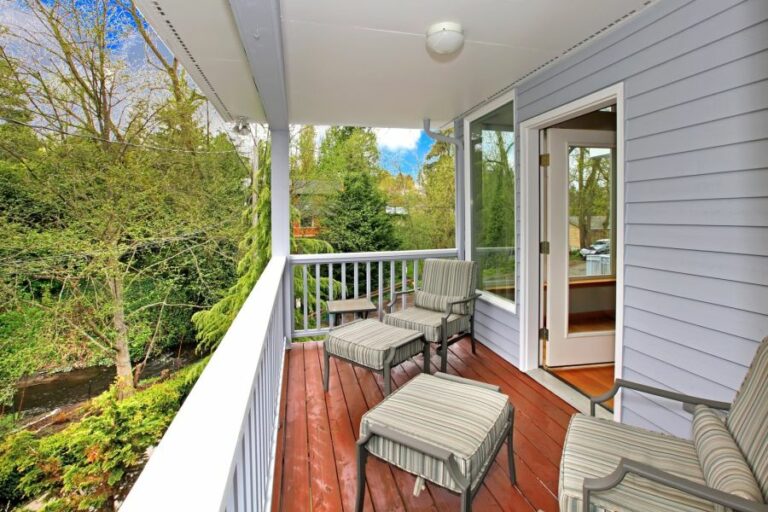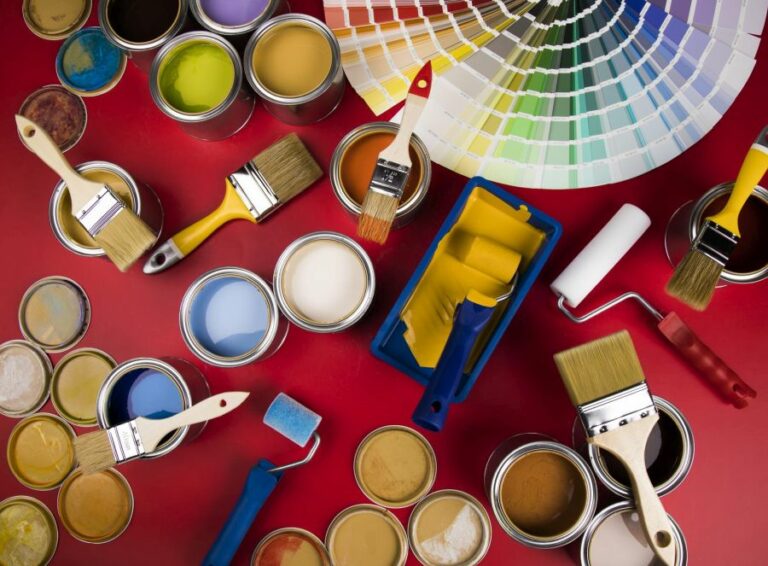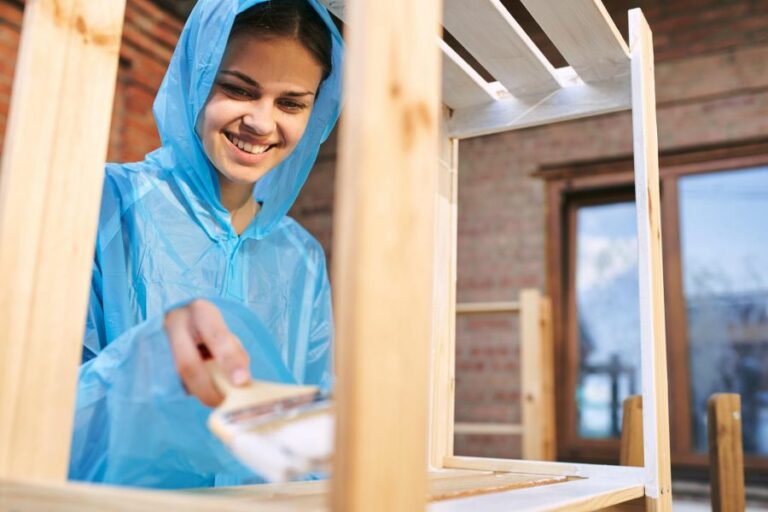Expert Guide: Choosing the Right Outdoor Wood Primer
Are you tired of seeing your wooden outdoor furniture and fixtures lose their charm due to constant exposure to the elements? Look no further, as this blog post on ‘Outdoor Primer Paint for Wood’ covers you. Discover the latest and most effective ways to give your exterior wood a well-deserved makeover while ensuring it remains protected and retains its luster for years.
Outdoor primer paint for wood:
Utilizing high-quality outdoor primer paint for wooden surfaces prolongs the life of paint jobs and enhances appearance. Outdoor primers offer enhanced paint adhesion, improved coverage, protection from moisture and rot, and a superior paint finish.
When selecting a primer, consider oil-based vs. water-based primer for treated or untreated wood, and use stain-blocking primers when needed. Ensure proper application by preparing the surface, choosing the right tools, applying in ideal weather conditions, allowing adequate drying time, and testing compatibility.

Discover the top outdoor primer paints for wood, and learn how to choose the perfect one for your next project. I am sharing expert advice, best practices, application tips, and our top recommendations to enhance your wooden surfaces’ beauty and durability. Stay tuned!
Contents
- 1 Exterior Primer Paint for Wooden Surfaces
- 2 Which Primer is Best Suited for Exterior Wood Surfaces?
- 3 Is it necessary to apply primer on exterior wood surfaces before painting?
- 4 Is a Special Primer Necessary for Exterior Wood Surfaces?
- 5 What is the Most Effective Primer for Painting Over Wooden Surfaces?
Exterior Primer Paint for Wooden Surfaces
When protecting and beautifying wooden surfaces outdoors, utilizing a high-quality primer goes a long way. A well-selected and properly applied outdoor primer paint for wood can prolong the life of your paint job and enhance the appearance of the surface.
I will discuss various aspects of outdoor primer paint for wood, including its benefits, how to choose the suitable type, and application tips for best results.
• Benefits of Outdoor Primer Paint for Wood
Outdoor primers offer myriad benefits, mainly aimed at enhancing the performance and appearance of the final paint job. Here are some of the key advantages:
– Enhanced Paint Adhesion
Primer paint creates a smooth, uniform surface that allows the topcoat to adhere properly. This increased adhesion results in a longer-lasting and more durable paint job, especially on wooden surfaces exposed to the elements.
– Improved Paint Coverage
Applying primer before the topcoat helps to hide surface imperfections and ensures better color consistency. This means you may need fewer coats of paint to achieve an even and professional finish, thus saving time and effort.
– Protection from Moisture and Rot
Outdoor wooden surfaces are highly susceptible to moisture and rot. A high-quality exterior primer paint for wood helps seal the surface, preventing water absorption and rot. This added layer of protection is essential for maintaining the structural integrity of your wooden surfaces.
– Superior Paint Finish
A good primer can fill in small cracks and pores in the wood, creating a smoother surface for your topcoat. This results in a better-looking paint finish that showcases the beauty of your wooden surfaces.
• Choosing the Right Primer for Your Wood
When selecting the best exterior primer paint for wood, there are a few key factors to consider. These include:
– Oil-based or Water-based Primers
Two main types of primers are available: oil-based and water-based (also known as latex primers).
Oil-based primers are highly durable and provide excellent adhesion and stain-blocking properties. They are suited for high-traffic areas or surfaces exposed to harsh weather conditions. However, they can emit strong fumes and take longer to dry.
Water-based primers are easier to work with and offer a more environmentally-friendly option, as they have lower volatile organic compounds (VOC) levels. They also dry faster and are easier to clean up. However, they may not be as effective in blocking stains and require additional coats for complete coverage.
In most cases, water-based primers are sufficient for outdoor wood projects, but if you need heavy-duty protection, consider using an oil-based primer.
– Primer for Treated or Untreated Wood
For untreated wood, choose a primer specifically designed for raw wood surfaces. These primers usually contain more resins that seal the wood pores and improve adhesion.
For treated wood, ensure the primer is compatible with the specific type of treatment applied to the wood, such as pressure or chemical treatment. Always consult the manufacturer’s instructions on the primer packaging to confirm compatibility.
– Stain-blocking Primers
Stain-blocking primers are essential when painting over surfaces with water, smoke, or ink stains or using light paint colors over dark wood. These primers help prevent the underlying stains from bleeding through the new paint job.
• Application Tips for a Successful Primer Coat
To achieve the best results when applying primer paint to outdoor wood surfaces, follow these simple tips:
- Preparation is key: Begin by thoroughly cleaning and sanding the wooden surface to remove dirt, grease, and any loose paint or wood fibers. This step ensures your primer adheres properly and creates a smooth base for the topcoat.
- Choose the right tools: Use a high-quality paintbrush or paint roller designed for exterior use. These tools can help you achieve a smoother, more even application.
- Apply primer in ideal weather conditions: Dry and mild weather is best, as high humidity or low temperatures can affect its drying and curing process.
- Allow adequate drying time: Follow the manufacturer’s instructions for drying time between coats. Typically, water-based primers dry within a few hours, while oil-based primers can take up to 24 hours to cure fully.
- Always test compatibility: If you have concerns about your primer or paint’s compatibility, always test a small, inconspicuous surface area before proceeding with the full application.
By keeping these factors in mind and following the proper application techniques, you will be well on your way to achieving a stunning and long-lasting finish on your outdoor wood surfaces.
Remember, investing in high-quality outdoor primer paint for wood is essential in ensuring the success and durability of your exterior paint projects.
Which Primer is Best Suited for Exterior Wood Surfaces?
Using the right primer is crucial when preparing exterior wood surfaces for painting. A good primer will improve adhesion, provide a uniform topcoat base, and help protect the wood from moisture, rot, and mold.
With so many primer options on the market, choosing the right one for your project can be overwhelming. I will guide you through selecting the best primer for exterior wood, considering factors such as durability, compatibility with the topcoat, and performance on various wood types.
• Oil-Based Primers: Classic Durability
Oil-based primer is one of the most common and reliable types of exterior wood primer. Oil-based primers are highly durable, penetrating deep into the wood fibers to provide a strong bond with the topcoat.
This type of primer is well-suited for both softwoods and hardwoods, and it excels at sealing and protecting porous surfaces.
I recommend using an oil-based primer for:
- Weathered or previously painted wood
- High-moisture areas, such as doors and window frames
- High-tannin woods like cedar and redwood, which are prone to bleed through
Some popular oil-based primers for exterior wood include:
- Zinsser Cover Stain
- KILZ Original Exterior
- Sherwin-Williams Exterior Oil-Based Wood Primer
Remember that oil-based primer have a strong odor and require solvent-based thinners and cleaners for cleanup.
• Water-Based Primers: Easy Application and Cleanup
Water-based primers, also known as acrylic or latex primers, are another popular option for exterior wood. These primers provide a more environmentally friendly alternative to oil-based primers, with lower VOC levels and easier water-based cleanup.
While they may not penetrate as deeply as oil-based primers, water-based primers provide excellent adhesion and create a flexible, breathable barrier between the wood and topcoat. This helps prevent issues like peeling and cracking.
I recommend using a water-based primer for:
- New, untreated wood
- Lightly stained or sealed wood
- Projects where low odor and easy cleanup are important
Some popular water-based primers for exterior wood include:
- Zinsser Bulls Eye 1-2-3
- KILZ 2 Latex Primer/Sealer
- Benjamin Moore Fresh Start
• Shellac-Based Primers: Exceptional Stain Blocking
When it comes to stain-blocking performance, shellac-based primers are hard to beat. Known for their ability to seal surfaces and block tannin bleed, these primers create an excellent barrier on various wood types.
While not as commonly used for exterior applications due to their less flexible nature, shellac-based primers can be a good choice for spot-priming specific problem areas like knotty or resinous woods.
I recommend using a shellac-based primer for:
- Spot-priming on stain-prone areas
- Projects requiring exceptional tannin bleed blocking
Some popular shellac-based primers for exterior wood include:
- Zinsser B-I-N
- Rust-Oleum Zinsser Shellac-Base Primer
Remember that shellac-based primers are not water-resistant and require alcohol-based thinners for cleanup.
• Alkyd-Based Primers: Hybrid Performance
Alkyd-based primers are a newer generation of primers that combine elements of both oil and water-based primers. These primers are known for their excellent adhesion, resistance to tannin bleed, and durability.
They also offer improved drying times compared to traditional oil-based primers and easier cleanup than shellac primers.
I recommend using an alkyd-based primer for:
- Projects that require high performance and flexibility
- Sealing and protecting a variety of wood types
Some popular alkyd-based primers for exterior wood include:
- Benjamin Moore ADVANCE Primer
- PPG Gripper Primer & Sealer
• Conclusion
Selecting the right primer for exterior wood can greatly affect the quality and longevity of your paint job. Oil-based primers generally provide superior durability, water-based primers offer easy application and cleanup, shellac-based primers excel in stain-blocking, and alkyd-based primers provide performance benefits.
Consider the specific needs of your project, compatibility with your chosen topcoat, and the type of wood you’re working with when making your decision. With the right primer, you’ll be well on your way to a long-lasting, beautiful finish on your exterior wood surfaces.
Is it necessary to apply primer on exterior wood surfaces before painting?
• Why Priming is Essential
If you plan to paint exterior wood surfaces, priming is one crucial step you should not skip. Applying a primer on exterior wood ensures the longevity and durability of your paint job and guarantees a smoother, more even finish.
I will discuss why priming exterior wood is essential, its benefits, and some recommendations for primers and application techniques.
• Selecting the Right Primer for Exterior Wood
Choosing a primer specifically designed for outdoor use is important when priming exterior wood surfaces. Exterior wood primers contain additives and ingredients that help protect the wood from moisture, mildew, and sun damage. Here are some popular types of primers suitable for exterior wood:
– Oil-Based Primers
Oil-based primers are a popular choice for exterior wood surfaces due to their excellent adhesion properties and ability to seal porous surfaces effectively. They also offer superior stain-blocking capabilities and resistance to tannin bleeding from the wood.
However, oil-based primers have longer drying times and release strong fumes during application.
– Acrylic/Latex Primers
Acrylic or latex primers offer good adhesion and flexibility, essential for exterior surfaces exposed to harsh weather conditions. They are easier to clean up and produce fewer fumes than oil-based primers.
However, they may not provide the same stain-blocking or tannin bleeding protection as oil-based primers.
– Alkyd Primers
Alkyd primers balance the stain-blocking capabilities of oil-based primers and the ease of use of acrylic/latex primers. They typically have better adhesion properties and resistance to tannin bleeding than acrylic/latex primers but still release some fumes during application.
In my experience, I recommend using an oil-based primer or an alkyd primer for optimal protection and adhesion on exterior wood surfaces.
• Proper Surface Preparation for Priming
Before applying a primer, it is important to prepare the wood surface properly. Follow these steps to ensure optimal results:
- Clean the surface: Remove dirt, mold, and mildew using water and mild detergent. Scrub with a stiff bristle brush and rinse thoroughly with clean water. Allow the wood to dry completely before proceeding.
- Sand the surface: Lightly sand the wood surface using medium-grit sandpaper (120 to 150 grit) to remove loose or peeling paint and create a smooth surface for primer application. Wipe the surface clean with a tack cloth to remove dust and debris.
- Repair damaged areas: Inspect the wood surface for damaged or rotten areas. Use wood or epoxy filler to repair minor damages and replace heavily damaged boards or sections.
- Protect surrounding areas: Before applying the primer, tape off any adjacent surfaces or areas you do not want to paint to prevent primer and paint from spreading.
• Tips for Primer Application
When applying a primer to exterior wood surfaces, follow these recommendations to ensure optimal results:
- Choose the right application tool: Using a high-quality brush, roller, or paint sprayer can significantly improve the application of the primer. Choose a brush with synthetic bristles for acrylic/latex and alkyd primers and a natural bristle brush for oil-based primers.
- Apply primer in the right conditions: Avoid applying primer in direct sunlight, extreme temperatures, or windy conditions. Ideal temperature conditions for primer application range between 50-90 degrees Fahrenheit, with relative humidity below 85%.
- Apply the primer evenly: Apply a generous, even coat of primer to the wood surface using smooth, long strokes. Avoid overloading the brush or roller to prevent drips and runs.
- Allow the primer to dry: Follow the drying time recommendations on the primer’s label, usually overnight or 24 hours, before applying the topcoat.
• The Benefits of Priming Exterior Wood Before Painting
- Improved adhesion: Primer provides a sound base for the paint to adhere to, ensuring a stronger bond and reducing the risk of peeling and blistering.
- Enhanced appearance: Primers create a uniform surface that helps hide imperfections and provides a smoother, more even appearance for the final paint job.
- Protection from moisture: Primer acts as a barrier, preventing moisture from penetrating the wood and causing rot or mildew.
- Resistance to tannin bleeding: Primers reduce the chances of tannin staining from the wood, resulting in a cleaner and more consistent appearance for the paint job.
- Increased paint durability: By providing a solid, even base for the paint, primers help to promote a longer-lasting finish.
In conclusion, priming exterior wood before painting is crucial in ensuring a durable, long-lasting, and attractive paint job. Take the time to choose the right primer, properly prepare the surface, and follow the recommended application techniques for the best possible results.
Is a Special Primer Necessary for Exterior Wood Surfaces?
Painting exterior wood surfaces like decks, fences, and siding is not only aesthetically appealing but also extends the life of the wood by protecting it from environmental damage like moisture and UV rays. But before the paint, it’s crucial to apply an appropriate primer.
So, do you need a special primer for exterior wood? Yes, you do! This guide provides an in-depth look at exterior wood primers, why you need them, and how to choose the right one.
• Why Use a Primer on Exterior Wood
Applying a primer to exterior wood surfaces holds several benefits that ensure durable, long-lasting protection and an attractive, even finish. These benefits include:
– Surface Preparation
A primer prepares the wood’s surface, making it smoother and more even. It fills in wood pores and minor defects, providing a consistent base for the paint to adhere to.
– Enhancing Paint Adhesion
A primer increases paint adhesion, reducing the chances of peeling, blistering, or flaking. It establishes a strong bond between the wood and paint, ensuring a longer-lasting finish.
– Stain Blocking
Exterior wood tends to develop stains from the natural aging, weather damage, or wood extractives. A primer forms a barrier against these stains, preventing them from bleeding through the paint.
– Moisture Protection
Wood absorbs moisture and is susceptible to rot, mildew, and warping. A primer slows down moisture penetration from the environment, preserving the wood’s integrity and increasing its lifespan.
• Types of Exterior Wood Primers
There are three main types of exterior wood primers:
– Oil-Based Primers
These primers are made with an oil-based solvent and offer outstanding adhesion and stain-blocking capabilities. They are generally slower to dry and have a strong odor. However, they provide excellent protection for wood surfaces, especially in harsh weather conditions.
– Water-Based Primers (Latex)
These primers are water-soluble, and their formulation contains latex. They dry quickly, have a low odor, and are easier to clean. However, they generally provide lower stain-blocking abilities compared to oil-based primers.
– Shellac Primers
These primers offer superior stain-blocking capabilities and quick-drying properties. However, they have a strong odor and are less durable than oil-based or water-based primers. Shellac primers are best suited for interior wood surfaces.
• Choosing the Right Exterior Wood Primer
Here are some key considerations when selecting the right primer for your exterior wood project:
– Wood Condition
The condition of the wood plays a significant role in determining the type of primer required:
- For new, bare wood, I recommend using a high-quality oil-based primer to seal the wood and provide excellent adhesion.
- For weathered or aged wood, it’s essential to clean and sand the surface first, then use a latex primer to seal and protect the wood.
- For wood with knots or tannin, shellac or oil-based primers offer superior stain-blocking capabilities and prevent tannin bleed-through.
– Environment and Weather Factors
The climate in your region also plays a significant part in deciding the appropriate primer:
- In areas with high humidity or substantial rainfall, oil-based primers offer better protection against moisture damage.
- In sunnier climates, water-based primers with added UV protection can help reduce sun damage to the wood.
– Compatibility with Topcoat Paint
Ensuring the primer is compatible with the topcoat paint you plan to use is vital. Generally, oil-based primers work well with both oil-based and latex topcoats. However, it would be best not to use latex primers with oil-based topcoat paints.
• Application Tips
- Before applying a primer, thoroughly clean the wood surface, removing dirt, mildew, and old paint. Proper surface preparation ensures better adhesion and a longer-lasting finish.
- When working with a water-based primer, consider adding a mildewcide to prevent mildew growth on the wood surface.
- Apply at least two coats of primer, allowing each coat to dry according to the manufacturer’s recommendations.
- Always follow the manufacturer’s instructions on the primer label for the best results.
• Conclusion
The answer to whether you need a special primer for exterior wood is a resounding yes. Priming is essential to ensure a smooth, even surface, enhance paint adhesion, block stains, and protect the wood against moisture damage.
Choosing the right primer depends on the wood condition, environmental factors, and compatibility with the topcoat paint. Following this guide’s guidelines, you can select the best primer for your exterior wood project, ensuring a long-lasting and beautiful finish.
What is the Most Effective Primer for Painting Over Wooden Surfaces?
• Understanding Wood Primers
A wood primer is an essential product that should be used before applying paint to wooden surfaces. It helps to seal and protect the wood, providing a smooth and consistent surface for painting.
Additionally, wood primers increase the paint job’s durability, thus ensuring optimal results and longevity. I will discuss the best wood primers for a professional, long-lasting paint job.
• Oil-Based Primer: A Classic Choice
Oil-based primer has been around for decades and is considered by many professionals as the gold standard for wood priming. Its advantages lie in its exceptional adhesion ability and strong sealing properties.
These features ensure the paint sticks well to the wood surface, thoroughly covering any knots, stains, or wood grains.
Some popular oil-based wood primers include:
- Zinsser Cover Stain: This product is popular for interior and exterior wood surfaces. It provides excellent adhesion, effectively seals knots, and dries within 2 hours, making it convenient for quick projects.
- Rust-Oleum Zinsser Bulls Eye 1-2-3: This oil-based primer is particularly known for its stain-blocking properties. It adheres effectively to various wood surfaces and is suitable for interior and exterior projects.
However, it is crucial to note that oil-based primers come with strong fumes and require adequate ventilation during application. Additionally, they take longer to dry than other primers, and the cleanup process requires mineral spirits or paint thinner.
• Water-Based Primer: A Greener Alternative
Water-based primers, also known as acrylic or latex primers, have gained popularity due to their environmentally friendly nature and easier application process. They contain lower volatile organic compounds (VOCs), producing less toxic fumes during application.
Additionally, they dry faster and can be easily cleaned up with water.
Some excellent water-based wood primers include:
- KILZ Premium High-Hide Stain-Blocking Latex Primer: This primer is suitable for interior and exterior wood surfaces. It provides excellent adhesion and stain-blocking properties and can be easily sanded for a smooth finish.
- Zinsser 123 Water-Based Primer: Another popular choice among professionals, this primer sticks well to various surfaces, including wood. It dries quickly and can be recoated in an hour.
Though water-based primers are more environmentally friendly, they may not be as effective as oil-based primers in sealing knots and tannin bleeds, particularly in hardwoods like oak, cedar, or redwood.
• Shellac-Based Primer: The Stain-Buster
Shellac-based primers are a versatile option that professionals often turn to when dealing with stubborn stains and odors. These primers seal knots and block out stains caused by water, smoke, or tannins.
A leading shellac-based primer option is Zinsser B-I-N Shellac-Base Primer. This primer is renowned for its excellent adhesion and stain-blocking capabilities. It dries within 45 minutes, enabling you to finish your project promptly.
The downside of shellac-based primers is that they produce strong fumes during application and require denatured alcohol for cleanup.
• Making the Right Choice for Your Project
Selecting the best primer to paint over wood depends on the specific requirements of your project. Here are some factors you should consider when making your choice:
- Surface condition: If the wood surface has significant stains, knots, or tannin bleeds, an oil-based or shellac-based primer is recommended. Water-based primers may not be as effective in sealing stains or knots.
- Indoor or outdoor: For outdoor projects, it is essential to choose a primer that offers excellent adhesion, durability, and resistance to environmental factors. Oil-based or water-based primers with specific outdoor formulations are advisable.
- Drying time and fumes: If you have limited working time or are sensitive to strong odors, a water-based primer might be the best choice due to its fast drying time and lower VOC levels.
- Ease of cleanup: If you prefer a more straightforward cleanup process, a water-based primer, which can be cleaned up with water, will be more suitable than oil-based or shellac-based primers.
In conclusion, the best primer to paint over wood depends on your project’s specific conditions. Considering these factors will enable you to select a primer with the best performance and results for your painting project. Always follow the manufacturer’s instructions for proper application and adhere to necessary safety precautions during priming.
Primer Name | Brand | Type | Benefits |
|---|---|---|---|
Zinsser B-I-N Shellac-Based Primer | Zinsser | Shellac-Based | Excellent adhesion and stain blocking |
KILZ Premium High-Hide Stain Blocking Primer | KILZ | Water-Based | Stain blocking, mildew resistant, and fast-drying |
Rust-Oleum Zinsser Bulls Eye 1-2-3 Primer | Rust-Oleum | Water-Based | Adheres to glossy surfaces, seals porous surfaces, and blocks moderate stains |
Zinsser Cover Stain Oil-Based Primer | Zinsser | Oil-Based | Indoor and outdoor use, blocks stains, and seals porous surfaces |
KILZ Original Multi-Surface Stain Blocking Primer | KILZ | Oil-Based | Excellent adhesion and stain blocking, fast-drying, and seals odors |







